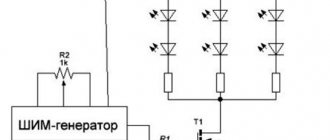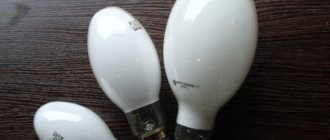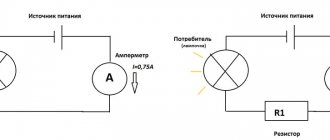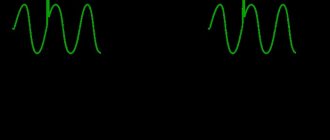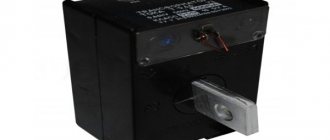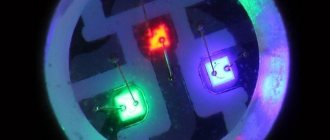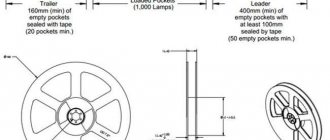Due to the global development of technology, LEDs have become widely used in electronics. They have many features, including compactness and bright light. In addition to the rated current, which is their main parameter, you need to know the operating voltage of the LEDs. This parameter is often used for calculations. If you choose the right device parameters, you can extend its service life. The voltage for the LED is the potential difference at the pn junction, which is noted in the device data sheet. There are times when there is no information about a specific product, then the question arises: “How to determine the voltage drop across an LED?”
How to correctly decipher the marking?
SMD LED markings provide the user with brief information about the products. For example, we have a light-emitting diode labeled SMD 2835 UWC 5. We decipher: standard size 2835 with dimensions 2.8x3.5 mm, power 0.5 W, white tint.
| SMD type | Number of crystals | Dimensions, mm |
| 3528 | 1 | 3.5x2.8x1.4 |
| 5050 | 3 / 4 | 5x5x1.6 |
| 5630 | 1 | 5.6x3x0.75 |
| 5730 | 1 / 2 | 5.7x3x0.75 |
| 3014 | 1 | 3x1.4x0.75 |
| 2835 | 1 | 2.8x3.5x0.8 |
How to identify an LED by appearance?
| SMD type | Number of crystals | Dimensions, mm | Power, W | Current, mA | Light flux, Lm |
| 3528 | 1 | 3.5x2.8x1.4 | 0,02 / 0,06 | 20 | 5-7 |
| 5050 | 3 / 4 | 5x5x1.6 | 0,02 | 60 / 80 | 18-20 |
| 5630 | 1 | 5.6x3x0.75 | 0,2-0,4 | 150 | 58 |
| 5730 | 1 / 2 | 5.7x3x0.75 | 0,5 / 1 | 150 / 300 | 50 / 158 |
| 3014 | 1 | 3x1.4x0.75 | 0,1-0,12 | 30 | 9-13 |
| 2835 | 1 | 2.8x3.5x0.8 | 0,2 / 0,5 / 1 | 60 / 150 / 300 | 20 / 50 / 100 |
How to determine the polarity of an LED?
In the transparent body of the output LED, you can see the anode and cathode of a characteristic shape.
On SMD packages, an angular cut is visible, indicating the cathode terminal. On the back side there is a heat sink pad, shifted towards the anode.
Brief technical specifications
Although their digital markings do not carry any information about the characteristics of SMD LEDs, there is still some connection between the standard sizes and parameters of the devices. Let's consider the parameters of the most common types of light-emitting SMD semiconductors:
Main technical characteristics of SMD LEDs
| Device type | Case dimensions, mm | Number of crystals | Power, W | Luminous* flux, lm | Operating current, mA | Operating temperature, °C |
Main conclusions
The ability to determine the operating characteristics of an LED allows you to create an optimal operating mode for it. As a result, the element will be able to demonstrate maximum service life and efficiency, and produce sufficient brightness without overload. Knowing the nominal parameters of the device will allow you to correct connection errors, select the most suitable type of power source, and avoid emergency situations or overloads. The ability to correctly determine the characteristics of an LED implies knowledge of various testing methods, from a simple determination of performance, to a more detailed test of operating current, voltage and power. This will expand the possibilities and allow you to use one of the options available in the given conditions.
Previous
LEDsHow to choose LED lights for the garage and organize lighting
Next
LEDsWhich is better: halogen or LED lamps for home and car
What kind of LEDs are in the lamps?
Probably the most common occurrence is when you open the lamp and there is the following picture: one of the diodes has burned out. If you have the time and desire to carry out repairs, you can replace the failed diode. But the question arises: What LEDs are in the lamps?
Accordingly, our procedure
- You need to use a voltmeter and determine the voltage of the LED. How to check an LED can help you with this
- Next, after you have determined whether the entire LED module has failed or a single LED. You need to determine the type of LED, namely its housing dimensions. They are measured in millimeters. Our article LED Dimensions can help you with this. But the article may not be useful since manufacturers often write the type of LED on the board itself. See photo. It will indicate 2835, 5050 or 5630, this is the type of LED
- Further, knowing the diode body and its voltage, it will not be difficult for you to purchase the LEDs or LED modules you need on Aliexpress. Or remove the diode from another similar LED lamp.
Methods for creating circuits from several LEDs - serial and parallel connection
When connecting several light-emitting devices to a power source, two connection options can be used - serial and parallel.
Sequential
A series connection represents a circuit of semiconductor devices in which the cathode of the first emitter is soldered to the anode of the next one - and so on. A current of the same value flows through all elements of a series circuit, and the voltage drop is summed up. The power of the power supply is selected equal to or greater than the sum of the powers of each element.
Cons of serial connection:
- If there are a significant number of circuit elements, it is necessary to choose a high-voltage power supply.
- If one LED diode fails, the entire circuit stops working.
In long strips with 60-70 diodes on each element there is a voltage drop of approximately 3 V, that is, such strips can be connected to a 220 V network through a rectifier.
Parallel
When connected in parallel, the voltage on all elements of the circuit will be equal, and the currents of each LED will be summed up. The main problem in this case is that LED lamps, even from the same batch, often have different characteristics. Therefore, if you put one common resistor, different current values can be supplied to the light bulbs, as a result of which some elements will shine too brightly, while others will shine dimly. The solution to the problem is to install separate resistors for each diode.
Disadvantages of parallel connection:
- a large number of circuit elements due to the need to use individual resistors for each diode;
- a significant increase in load when one LED diode burns out (if one powerful resistor is used for the entire circuit).
Mixed
This is the most suitable option for connecting LEDs, since it allows you to at least partially compensate for the disadvantages of serial and parallel connections. In this case, chains of sequential elements are connected in parallel. This method is used in modern Christmas tree garlands or ribbons. The advantage of this solution: even if one or more parallel chains fail, the rest will continue to light properly.
How many volts are LEDs?
The parameters of LEDs mostly depend on the material from which the pn junction is made, although some of the characteristics still depend on the design. Typical values of operating voltage and glow color for low-power elements at a current of 20 mA are summarized in the table:
| Material | Glow color | Direct voltage range, V |
| GaAs, GaAlAs | Infrared | 1,1 – 1,6 |
| GaAsP, GaP, AlInGaP | Red | 1,5 – 2,6 |
| GaAsP, GaP, AlInGaP | Orange | 1,7 – 2,8 |
| GaAsP, GaP, AlInGaP | Yellow | 1,7 – 2,5 |
| GaP, InGaN | Green | 1,7 – 4 |
| ZnSe, InGaN | Blue | 3,2 – 4,5 |
| Phosphor | White | 2,7 – 4,3 |
Powerful lighting LEDs operate at high currents. Thus, the crystal of the popular LED 5730 is designed for long-term operation at a current of 150 mA. But due to the steep current-voltage characteristic, which stabilizes the voltage drop, its Urab is about 3.2 V, which fits into the value indicated in the table.
Read also: Fire brigade
Comparison table of reviewed LED SMDs
The summary table shows the characteristics of all the LEDs considered.
| No. | product name | Case dimensions, mm | Number of crystals, pcs | Power, W | Luminous flux, Lm | Luminescence angle, ⁰ |
| 1 | SMD 3528 | 3.5x2.8 | 1 or 3 | 0.06 or 0.2 | 0,6 – 5 | 120 or 140 |
| 2 | SMD 5050 | 5.0x5.0 | 3 or 4 | 0.2 or 0.26 | 2 – 14 | 120 or 140 |
| 3 | SMD 5630 | 5.6x3.0 | 1 | 0,5 | 57 | 120 |
| 4 | SMD 5730 | 5.7x3.0 | 1 or 2 | 0.5 or 1 | 50 – 158 | 120 |
| 5 | SMD 3014 | 3.0x1.4 | 1 | 0,12 | 9 -11 | 120 |
| 6 | SMD 2835 | 2.8x3.5 | 1 | 0.5 or 1 | 50 -100 | 120 |
| 7 | SMD 0805 | 2.0x1.2 | 1 | 0,125 | 0,35 | 120 |
| 8 | SMD 1206 | 3.2x1.6 | 1 | 0,25 | 0,35 | 120 |
| 9 | SMD 0603 | 1.6x0.8 | 1 | 0,1 | 0,35 | 120 |
| 10 | SMD 4014 | 40x1.4 | 1 | 0,2 | 120 | 120 |
| 11 | SMD 1608 | 1.6x0.8 | 1 | 0,25 | 0,35 | 120 |
| 12 | SMD 3014 | 3.0x1.4 | 1 | 0,1 | 11 | 120 |
| 13 | SMD 7020 | 7.0x2.0 | 1 | 0,5 | 70 | 120 |
| 14 | SMD 3020 | 3.0x2.0 | 1 | 0,06 | 10 | 120 |
Explanation of SMD LED markings
LED brands are designated in order to make their use more convenient. Only 4 digits are used for this, so it’s not difficult to “unravel” the designation.
Devices are classified by size, and the marking essentially indicates the size of the product. The numbers indicate the length and width in millimeters. For example, model 3528 has dimensions of 3.5 * 2.8 mm. Other information about the device can be obtained from the instructions.
Important! It is useful to study the instructions, since many Chinese manufacturers install lower-power chips in a typical case. At the same time, it is easy to purchase an LED with a power of 0.1 W instead of 1 W.
What's happened
The basis of the design is a semiconductor crystal or chip, which is located on a special base and enclosed in a plastic case. At the bottom there are contacts that allow you to mount the LED on any surface. A lens mounted on top of the crystal is responsible for effective light scattering.
The semiconductor crystal is mounted on a massive base, which, together with wide contacts, effectively removes the heat generated during operation.
As a result of this arrangement, it became possible to install them directly on a printed circuit board.
How to determine the parameters of an LED by appearance?
The easiest way is to find out the characteristics of an LED by its appearance. To do this, just type the following phrase into the search engine: “buy LED.” Next, from the list provided, you should select the largest online store and find the corresponding section of the catalog. Then carefully review all available positions and if luck smiles on you, you will find what you are looking for. As a rule, in serious online stores where radio-electronic elements are sold, each item has the corresponding documentation, datasheet or basic characteristics. By comparing the appearance of the existing LED with the one in the catalog, you can thus find out its characteristics.
The following approach is used by more experienced electronics engineers. However, there is nothing complicated about it. The vast majority of LEDs are divided into indicator and general purpose. Indicator lamps, as a rule, shine less brightly than others. This is understandable, because very bright light is not needed for indication. Indicator LEDs are used to signal the operation of various electronic devices. For example, when plugged into a power outlet, they indicate that the device is energized. They are found in kettles, laptops, switches, chargers, computers, etc. Their electrical parameters, regardless of appearance, are as follows: current – 20 mA = 0.02 A; voltage averages 2 V (from 1.8 V to 2.3 V).
General purpose LEDs shine brighter than the previous ones, so they can be used as lighting devices. However, they will also work for display if the current is reduced. Oddly enough, the vast majority of such LEDs also have a rated current consumption of 20 mA. But their voltage can range from 1.8 to 3.6 V. Super-bright LEDs are also in this class. At the same current, their voltage is usually higher - 3.0...3.6 V.
In general, LEDs of this type have a standard size range, the main parameter of which is the diameter of the lens circle or the width and thickness of the side if the lens is rectangular in shape.
Lens diameter, mm: 3; 4.8; 5; 8 and 10.
Rectangle sides, mm: 3×2; 5x2.
Method 1
A small fragment of PCB, literally a piece, but always with double-sided foil. A “spot” of solder must be applied to each so that in the future you can easily fix the wires and leads of the device for testing the LED. Probes from the multimeter, from which you should cut off (or unsolder, and then restore everything) the plug. The free ends need to be cleaned and tinned, that is, prepared for soldering. Paper clips – 2 pieces. They are given a shape that is clearly visible in the figure below. These will be the terminals of the device (analogous to plugs) that are connected to the multimeter. Although this is not the only option. Instead of paper clips, you can use flexible steel wire by cutting a couple of pieces of the required length.
LEDs.
The main thing is that these leads are slightly cushioned, then it will be much easier to connect them to the multimeter socket. Soldering acid. Using traditional pine flux is futile. The paper clips are made of steel, so the usual method for securely fixing them on PCB is of little use. Soldering iron. Power – at least 65 W. Trying to secure a paper clip to the board with a mounting tool (24, 36 W) is a waste of time. You will need to lay the melt in a relatively thick layer, and a low-power (miniature) soldering iron is useless in this case. Multimeter. These household appliances are available in several modifications. Their main difference is in functionality, that is, the ability to measure certain parameters of the circuit and parts.
It will be interesting➡ How to choose a phone charger and make it yourself
You will need a multimeter that can test transistors. In principle, everything you need to make a simple device for checking an LED with a multimeter is always at hand. In the end it should look something like this. In order not to be confused with the polarity of connecting the probes to the LED, the terminals of the device should be slightly shifted from the center line. Then it’s easy to remember where the conditional “+” and “–” are. Checking the LED You need to insert the “contacts” of the device into the plug for testing Tr (anode terminal - to connector E, cathode - to C), put the multimeter switch in the “Transistor measurement” (hFE) position and attach the probes to the board at the points where they are soldered legs of the device (from the front or back, whichever is more convenient). If it is working properly and the polarity is correct (plus to the anode), it will begin to glow.
Application of SMD LEDs
LED lamps are used so widely that it is impossible to list all areas of application.
Most often, devices of this kind are found in the following products:
- pocket and tactical flashlights - 6 volt LED lamps are installed here;
- lamps and turn signals on cars;
- household lighting products of various types;
- decorative lighting, mounted both inside and outside the building, uses crystals that generate different colors;
- signs, indicators, traffic lights, billboards;
- SMD LEDs are extremely popular in landscape design; the elements are not afraid of vibration and low temperature, which allows you to organize the most interesting lighting options;
- Low-current modifications are actively used for indication.
In each case, diodes of the required power are selected. In this case, the color of the light flux is taken into account.
Advantages and disadvantages
More and more users are seeking to replace outdated incandescent lamps with modern models of LED lamps. The main advantages of using LEDs:
- saving energy without compromising the luminous flux of the lamp;
- durable materials of the body and internal elements: low probability of mechanical damage;
- long service life: several times higher than that of Ilyich bulbs;
- size: diodes are compact and quite mobile;
- high brightness;
- safety: minimum network voltage – 3-24V.
Disadvantages include high cost and the need for constant voltage. The price of products is gradually decreasing due to high consumer demand.
Tags
For lamps LED lamps Interior lamps Recessed lamps figured lamps Cardan lamps Linear lamps Furniture lamps LED strip or LED modules. all LED modules or LED modules all LED module
luminairestape lightingresponsecolorresistorssemiconductor serial sourcehomethanks to contactstwobest unitshighestdataLED componentsresistance technologyzener diodes


